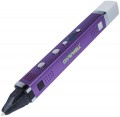Nozzle Diameter
The diameter of the nozzle provided in the pen.
The larger the nozzle, the thicker the lines produced by the pen will be (ceteris paribus; the actual thickness of the lines will also depend on the type of plastic and the adjusted temperature). In the thinnest models, the nozzle diameter is less than 0.5 mm, in the thickest models it is about 0.9 mm. Most modern 3D pens have nozzles in the range of 0.6 – 0.7 mm — this value is considered the most versatile and convenient for practical use.
Print Speed
The material feed rate provided by the pen. The higher this speed, the faster you can work with this model; on the other hand, the rapid supply of material requires increased accuracy and serious skills. The maximum value of this parameter in modern 3D pens is about 40 mm/s. Models with adjusted speed is also available (see below); for them, usually, the highest speed of operation is given in the specs.
Smooth Speed Adjust
The ability to smoothly change the feed rate of the material. The speed adjust allows you to set the mode of operation of the pen to the circumstances: for example, a low speed will be convenient for fine work, and a high speed is so for large elements. Specifically, the smooth speed adjust is convenient because it allows you to select almost any speed in the range from minimum to maximum.
In addition to this type, there is also a step adjustment, for more details, see “Number of Speeds”.
Number of Speeds
The number of fixed speed settings provided in the pen. This spec is specified only if there is more than one such setting.
The speed control allows you to adjust the mode of operation to the circumstances: for example, a low speed will be convenient for fine work, and a high speed is so for large elements. And the more speed settings there are in the pen, the wider the choice for the user to configure the device more accurately. In the most advanced models, the number of speeds can reach eight.
Note that the speed adjust can be not only stepwise, but also smooth (see above).
USB powered
The pen is powered by a standard USB connector. Such devices are as versatile as possible in connectivity: they can be powered via a PC, a portable device like a laptop or tablet, an external power bank, a USB wall charger or car charger.
Auto Power Off
Automatic power off of the pen for being idle for a while. Usually, auto-off triggers after a few minutes.
This feature is found mainly in models with a "hot" type of operation (see "Product Type"). It saves energy and reduces the risk of getting burned by accidentally touching the pen that is left on. However, there are also "cold" models with auto-off.
Tip Material
The material of the pen tip.
— Ceramics. Usually, high-durability varieties of ceramics are used in 3D pens, which also have low thermal conductivity. The latter has a positive effect on the quality of work, and also reduces the risk of getting burned. Theoretically, ceramic is a fairly brittle material, but practically, to damage such a tip, a very strong impact is needed, and the plastic body of the pen is more likely to crack than the ceramic nozzle. Thereby, most of the modern 3D pens use ceramics.
— Metal. Metal tips are considered more reliable and impact resistant than ceramic ones, and are somewhat cheaper. However, in fact, these differences are usually not noticeable. But the thermal conductivity of metal is significantly higher than that of ceramics, which is why such a tip heats up quite strongly during operation and requires additional care. Thereby, this material is much less common than ceramics.

